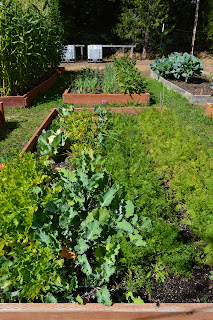When should you plan a garden?
When should you plan a garden?
If you are like me, the winter weather limits what I can do in my garden. That is why I use the winter months to plan my spring, summer, and winter garden succession. The winter months are the best time to plan a garden.
I start by browsing through the numerous seed catalogs I receive in the mail. I recommend purchasing seeds from a nursery in your area for a few reasons. The first is the plants are acclimated to your local climate, so you have a better chance of a bountiful harvest. Secondly, you will be supporting a local farmer.
Make a list of the plants you want to grow. The number of plants you can grown depends on your garden space. If you have not done so already, measure your garden bed and raised beds.
Now you can use the "Planting Guidelines" chart to determine how many plants you can grow in your garden space. I like to make a diagram of my garden area, which includes the raised beds' measurements. Remember to consider the plants sunlight requirements when arranging your garden.
SCHEDULE
Now you are ready to develop your schedule. You need to determine what the average last frost date for your area. The National Climate Data Center is a resource to determine average last frost date.
Simply select the State in which you reside and a PDF will open with a table full of information. On the left, is a list of cities – find the one closest to you. The next column has the probability of frost during (90, 50, and 10%) for the listed date.
You will use this information to plan when you need to start your seeds and when to plant the seedlings outside. Use the "Planting Guideline" table to determine when you need to start your seeds and when to set-out the plants.
Happy Gardening!
Planting Guidelines | ||||
Variety | Distance Rows (Inches) | Distance Plants (Inches) | Quantity per Person | |
Broccoli | 24 | 12 – 18 | 5 plants | |
Brussel’s Sprouts | 24 | 12 – 24 | 5 plants | |
Carrots | 12 | 1 – 3 | 10’ row | |
Cabbage | 24 | 12 – 18 | 5 plants | |
Cauliflower | 24 | 14 – 24 | 5 plants | |
Corn | 24 | 9 – 15 | 25’ row | |
Cucumbers | 48 | 12 | 10 – 15’ row | |
Onions | 12 | 2 – 4 | 10 – 20’ row | |
Parsnip | 18 | 3 – 6 | 5 – 10’ row | |
Peas | 12 | 1 – 3 | 50 – 100’ row | |
Potatoes | 30 | 9 – 12 | 50’ row | |
Pumpkin | 60 | 36 – 60 | 1 hill | |
Squash, Summer | 60 | 24 – 48 | 1 hill | |
Squash, Winter | 60 | 24 – 48 | 3 – 5 hills | |
Swiss Chard | 18 | 3 – 6 | 5’ row | |
Tomato | 30 | 12 – 24 | 5 plants | |
Specialty Varieties | ||||
Variety | Distance Rows (Inches) | Distance Plants (Inches) | ||
Beets | 12 | 2 – 4 | ||
Endive | 18 | 8 – 12 | ||
Kale | 18 | 18 – 24 | ||
Lettuce | 15 | 10 – 15 | ||
Radish | 12 | 1 – 2 | ||
Salsify | 18 | 2 – 4 | ||
Spinach | 15 | 2 – 6 | ||
Turnips | 15 | 2 - 6 | ||
Planting Timeline | ||
Key: Before Last Frost (BLF) / After Last Frost (ALF) | ||
Plant Variety | Start Seeds | Plant Out |
Marigold | 10 weeks BLF | AFL |
Sunflower | 10 weeks BLF | AFL |
Black-eyed Susan | 10 weeks BLF | AFL |
Artichoke | 8 weeks BLF | AFL |
Brussel’s Sprouts | 8 weeks BLF | AFL |
Broccoli | 8 weeks BLF | AFL |
Cabbage | 8 weeks BLF | AFL |
Cauliflower | 8 weeks BLF | AFL |
Zinnia | 8 weeks BLF | AFL |
Celery | 6 weeks BLF | 2 weeks AFL |
Eggplant | 6 weeks BLF | 2 weeks AFL |
Pepper | 6 weeks BLF | 2 weeks AFL |
Tomato | 6 weeks BLF | 2 weeks AFL |
Lavender | 6 weeks BLF | AFL |
Basil | 6 weeks BLF | 2 weeks AFL |
Sweet peas | 4 – 6 weeks BLF | 2 – 3 weeks AFL |




Comments
Post a Comment